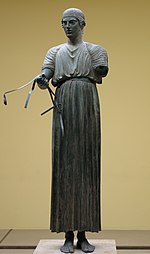Corinthian order

The corinthian order is one of the three main classical orders (styles) of ancient Greek and Roman architecture. The other two are the Doric order and Ionic order.
The Corinthian is the most decorative of the three orders. It has thin columns that have grooves running vertically up the sides. The most important difference with the other orders is the big capital (top part of the column), which is decorated with leaves and scrolls.
History[change | change source]
The oldest known example of a Corinthian column is in the Temple of Apollo Epicurius at Bassae in Arcadia, ca 450–420 BC. This column stands inside the temple and does not form part of the wall. The oldest use of the Corinthian order on the outside of a structure is the round Choragic Monument of Lysicrates in Athens. It was put in place around 334 BC.
Examples of Corinthian order architecture[change | change source]
- Greece
- Rome
- Pantheon, Rome (illustration)
- Temple of Mars Ultor
- Renaissance and Baroque
- Neoclassical and Beaux-Arts
- United States Capitol (illustration)
- St. La Salle Hall, Manila
- Don Enrique T. Yuchengco Hall, Manila
- Enrique M. Razon Sports Center, Manila
- Ukraine
- Great Lavra Belltower (fourth tier - 8 columns)
- Germany
- The Reichstag, Berlin

